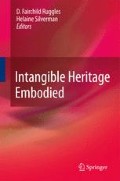Access this chapter
Tax calculation will be finalised at checkout
Purchases are for personal use only
References
Aufderheide, Patricia 1995 The Video in the Villages Project: Videomaking With and By Brazilian Indians. Visual Anthropology Review 11(2):83–93.
Berger, John 1972 Ways of Seeing. British Broadcasting Corporation, London; Penguin, New York.
Carelli, Vincent 1995 The Project and The Documentaries: Two Distinct and Complementary Dimensions of the “Video in the Villages” Project. Unpublished Ms., New York University, Center for Media, Culture and History, New York.
Elder, Sarah 1995 Collaborative Filmmaking: An Open Space for Making Meaning, A Moral Ground for Ethnographic Film. Visual Anthropology Review 11(2):94–101.
Farnell, Brenda 1995 Do You See What I Mean? Plains Indian Sign Talk and the Embodiment of Action. University of Texas Press, Austin.
Ginsburg, Faye 1991 Indigenous Media: Faustian Contract or Global Village. Cultural Anthropology 6(1):92–112.1993 Aboriginal Media and the Aboriginal Imaginary. Public Culture 5(3):557–578.1995 The Parallax Effect. Visual Anthropology Review 6:92–112.1997 “From Little Things, Big Things Grow”: Indigenous Media and Cultural Activism. In Between Resistance and Revolution: Cultural Politics and Social Protest, edited by Richard G. Fox and Orin Starn, pp. 118–144. Rutgers University Press, New Brunswick.2002 Screen Memories: Resignifying the Traditional in Indigenous Media. In Media Worlds: Anthropology on New Terrain, edited by Faye D. Ginsburg, Lila Abu-Lughod, and Brian Larkin, pp. 39–57. University of California Press, Berkeley.
Garfield, Seth 2001 Indigenous Struggle at the Heart of Brazil: State Policy, Frontier Expansion, and the Xavante Indians, 1937–1988. Duke University Press, Durham.
Graham, Laura R. 1983 Performance Dynamics and Social Dimensions in Xavante Narrative: Höimana'u'ö Wasu'u. Unpublished master’s thesis, Department of Anthropology, University of Texas at Austin.1995 Performing Dreams: Discourses of Immortality Among the Xavante of Central Brazil. University of Texas Press, Austin.2005 Image and Instrumentality in a Xavante Politics of Existential Recognition: The Public Outreach Work of Eténhiritipa Pimentel Barbosa. American Ethnologist 32(4):622–641.2007 Gender and the circulation of Xavante public culture. Paper presented at the annual meeting of the American Anthropological Association, November 2007, Washington, D.C.
Goffman, Irving 1975 Frame Analysis. Harper and Row, New York.
Grounds, Richard 2007 shadjwanE dathlandA (Rabbit and Wolf): Feeding Technology and Passing Forward Indigenous Languages. Closing Keynote, Indigenous Peoples in Digital Cultures: Communications Technologies and the Impacts on Indigenous Languages and Cultural Identity in the Americas. The University of Florida, Center for Latin American Studies. Gainesville, Florida, February 14–16.
Halkin, Alexandra 2009 Outside the Indigenous Lens: Zapatistas and autonomous video making. In Global Indigenous Media: Cultures, Poetics, and Politics, edited by Pamela Wilson and Michelle Stewart, pp. 160–180. Duke University Press, Durham.
Hymes, Dell 1975 Breakthrough into Performance. In Folklore: Performance and Communication, edited by Dan Ben-Amos and Kenneth Goldstein, pp. 11–74. Mouton, The Hague.1981 “In Vain I Tried to Tell You”: Essays in Native American Ethnopoetics. University of Pennsylvania Press, Philadelphia.
Lopes da Silva, Aracy 1992 Dois Séculos e Meio de História Xavante. In História dos índios no Brasil, edited by Manuela Carneiro da Cunha, pp. 357–378. Editora Schwarcz, Ltda., São Paulo.
Maybury-Lewis, David 1974 Akwẽ-Shavante Society, second edition. Oxford University Press, New York.
Michaels, Eric 1994 Bad Aboriginal Art: Tradition, Media, and Technological Horizons. University of Minnesota Press, Minneapolis.1994 [1986] A Primer of Restrictions on Picture-Taking in Traditional Areas of Aboriginal Australia. Reprinted in Bad Aboriginal Art: Tradition, Media, and Technological Horizons, pp. 1–18. University of Minnesota Press, Minneapolis.
Native Languages of the Americas website 1998–2007 www.native-languages.org/yuchi.htm (accessed 13 November 2007).
Prins, Harald E. 2002 Visual Media and the Primitivist Perplex: Colonial Fantasies, Indigenous Imagination, and Advocacy in North America. In Media Worlds: Anthropology on New Terrain, edited by Faye D. Ginsburg, Lila Abu-Lughod and Brian Larkin, pp. 58–74. University of California Press, Berkeley.
Ruby, Jay 1991 Speaking For, Speaking About, Speaking With, or Speaking Alongside: An Anthropological and Documentary Dilemma. Visual Anthropology Review 7(2):50–67.1995 The Moral Burden of Authorship in Ethnographic Film. Visual Anthropology Review 11(2):77–82.
Sherzer, Joel and Anthony C. Woodbury (editors) 1987 Native American Discourse: Poetics and Rhetoric. Cambridge University Press, Cambridge and New York.
Tedlock, Dennis 1977 Toward Oral Poetics. New Literary History 8(3):507–519.
Turner, Terence 1991 Representing, Resisting, Rethinking: Historical Transformations of Kayapo Culture and Anthropological Consciousness. In Colonial Situations: Essays on the Contextualization of Ethnographic Knowledge, edited by George Stocking, pp. 285–313. University of Wisconsin Press, Madison.1992 Defiant Images: The Kayapó Appropriation of Video. Anthropology Today 8(6):5–16.1995 Representation, Collaboration and Mediation in Contemporary Ethnographic and Indigenous Media. Visual Anthropology Review 11(2):102–106.2002 Representation, Politics, and Cultural Imagination in Indigenous Video: General Points and Kayapo Examples. In Media Worlds: Anthropology on New Terrain, edited by Faye D. Ginsburg, Lila Abu-Lughod, and Brian Larkin, pp. 75–89. University of California Press. Berkeley.
Urban, Greg 2001 Metaculture: How Culture Moves through the World. University of Minnesota Press, Minneapolis.
UNESCO 2003 Convention for the Safeguarding of Intangible Cultural Heritage. http://www.unesco.org/culture/ich/index.php?lg=EN&pg=00022 (accessed 29 March 2007).
Waiassé, Caimi 1996 One Must Be Curious (video, 16 min). Video nas Aldeias, Centro de Trabalho Indigenista, São Paulo.
Waiassé, Caimi and Jorge Protodi 2005 Darini: Iniciação Espiritual das Crianças Xavante (video, 46 min). Department of Communications, Methodist University and Nossa Tribo, São Paulo.
Author information
Authors and Affiliations
Corresponding author
Editor information
Editors and Affiliations
Rights and permissions
Copyright information
© 2009 Springer Science+Business Media, LLC
About this chapter
Cite this chapter
Graham, L.R. (2009). Problematizing Technologies for Documenting Intangible Culture: Some Positive and Negative Consequences. In: Silverman, H., Ruggles, D. (eds) Intangible Heritage Embodied. Springer, New York, NY. https://doi.org/10.1007/978-1-4419-0072-2_10
Download citation
DOI: https://doi.org/10.1007/978-1-4419-0072-2_10
Published:
Publisher Name: Springer, New York, NY
Print ISBN: 978-1-4419-0071-5
Online ISBN: 978-1-4419-0072-2
eBook Packages: Humanities, Social Sciences and LawSocial Sciences (R0)

